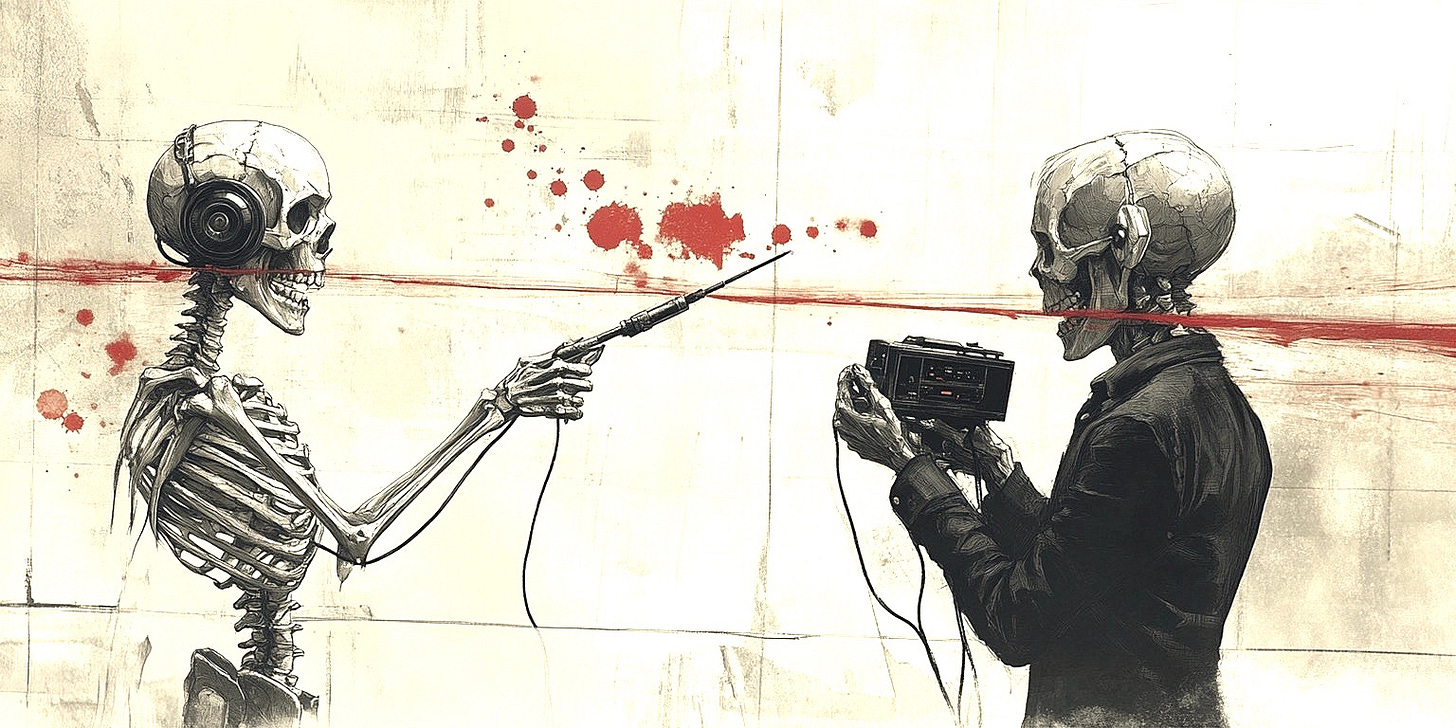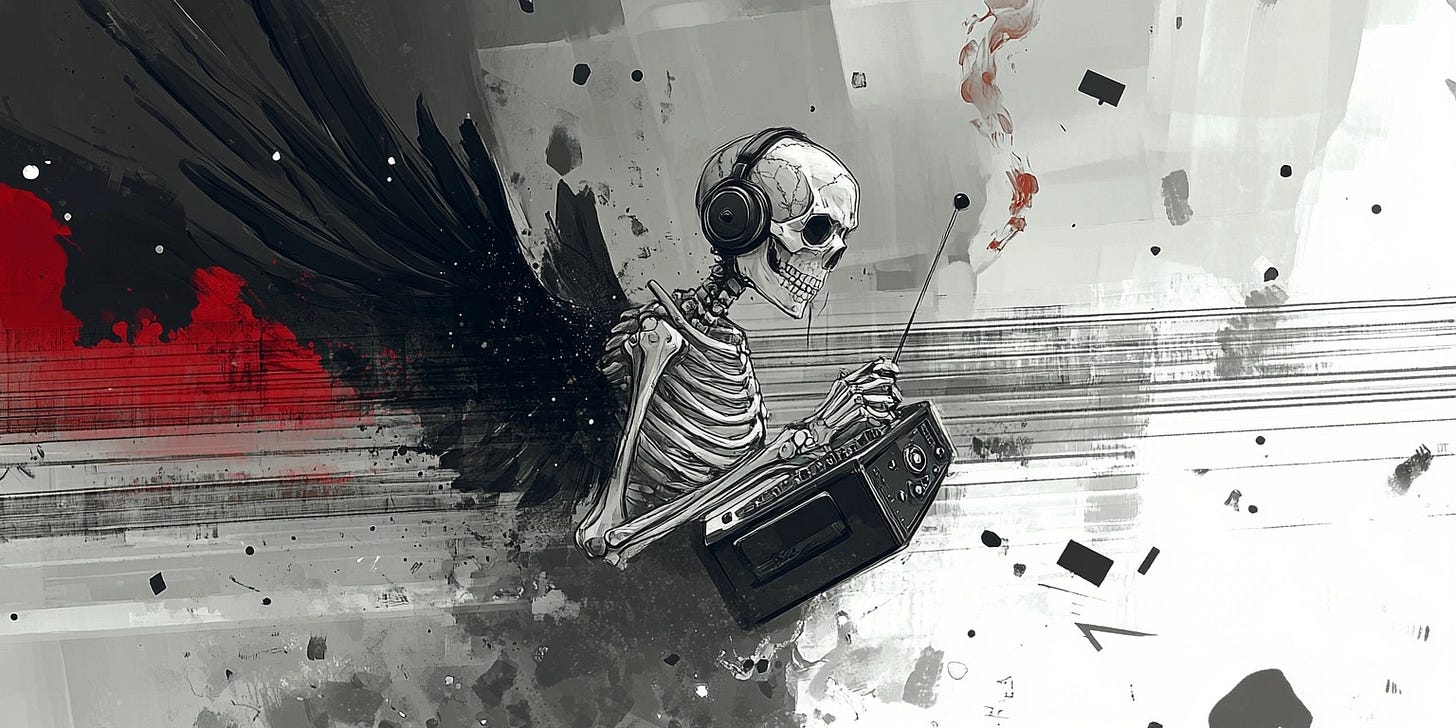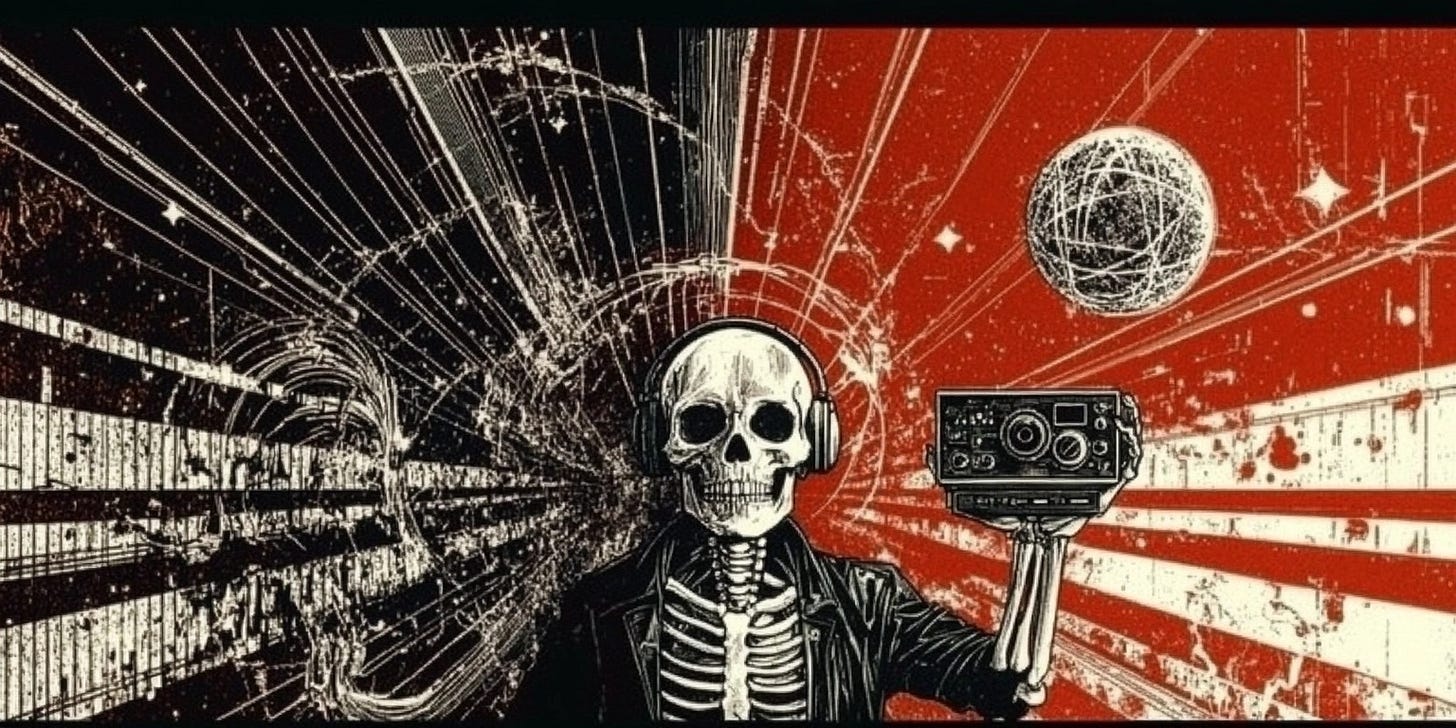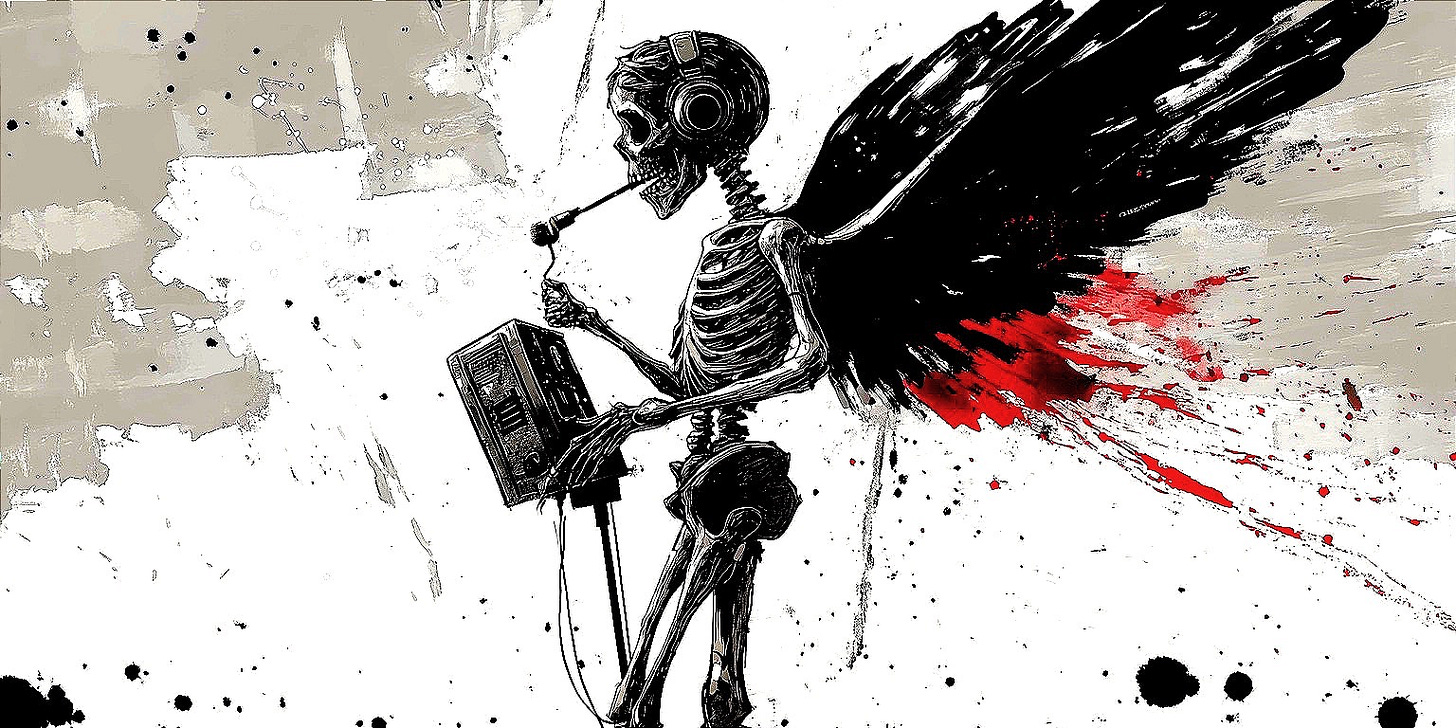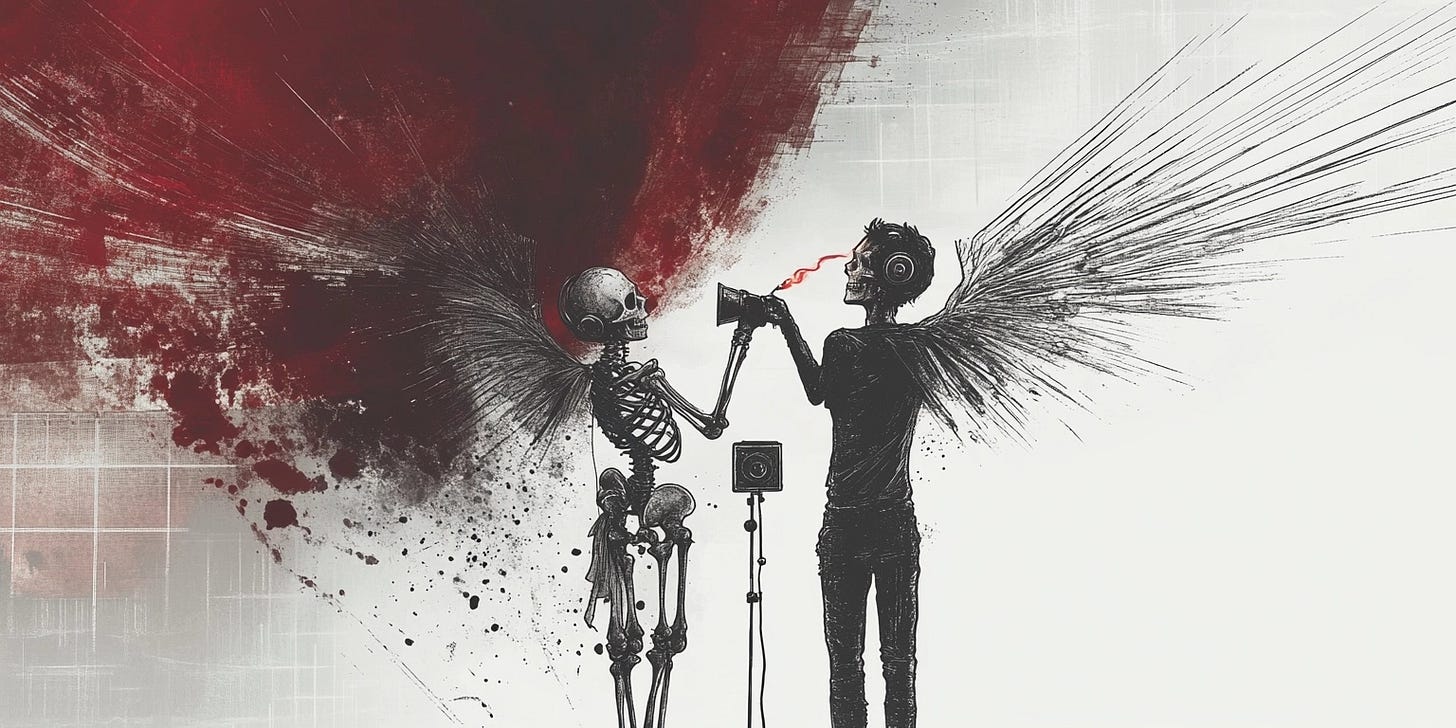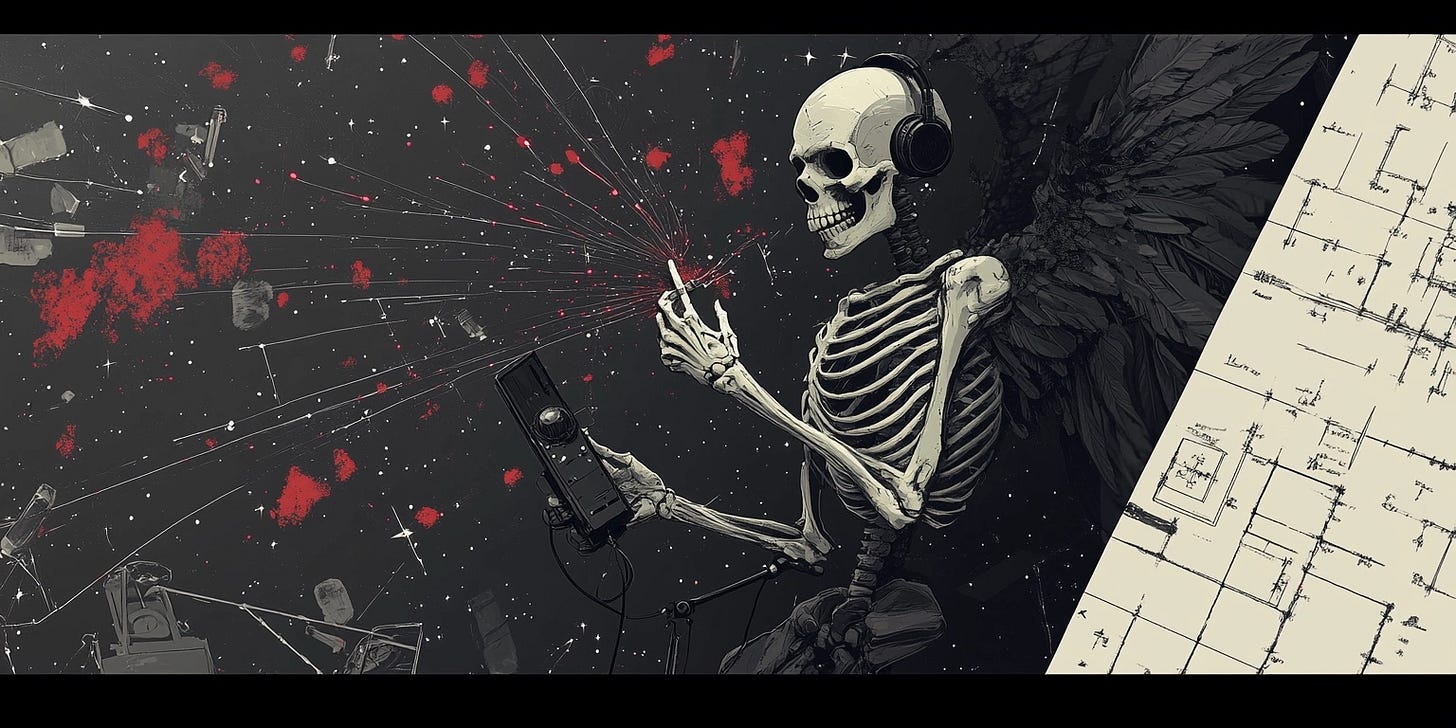What is Instrumental TransCommunication (ITC)?
A Deep Dive into EVP, Spirit Contact, and Interdimensional Communication
Before We Begin…
I still remember the first time I turned on a ghost box. It was a PSB-7 by Gary Galka, and I was standing in the quiet Sandhill Cemetery in Bartholomew County around 2008. As the device began sweeping, I wasn’t sure if I wanted it to work—but I was even more nervous that it might. Before that, I had tried the EVP classic route: digital recorder, empty room, hopeful questions.
What started as apprehension quickly became a lifelong obsession. Over time, I gravitated toward boutique spirit boxes—custom-made tools crafted with the intention and energy of the builders themselves. I became a collector, yes, but more than that, I became an experimenter. Through Paraholics, Obscura Vox, and years of real-world sessions, I’ve come to see ITC not just as paranormal experimentation, but as a process of connection—between technology, intent, and whatever lies just beyond our reach.
This article is the culmination of that journey—an exploration of where ITC has been, where it is now, and where it may be heading.
What is Instrumental TransCommunication?
Instrumental TransCommunication (ITC) is the practice of using technology as a bridge between the physical world and unseen intelligences, facilitating real-time communication with spirits, interdimensional entities, or unknown forms of consciousness. This evolving field encompasses everything from recording faint Electronic Voice Phenomena (EVP) on a digital device to sweeping radio waves with spirit boxes or tuning static for Direct Radio Voice (DRV)—all pushing the boundaries of conventional paranormal research.
ITC is often linked to afterlife communication, a common thread connecting it to ghost hunting. But unlike traditional ghost hunting, which typically relies on passive observation and subjective experiences, ITC is an interactive, experimental process. Researchers manipulate sound waves, radio frequencies, and digital signal processing to capture intelligent, responsive communication from seemingly nonphysical sources. Some believe these voices belong to departed spirits, while others suggest ITC may establish contact with extraterrestrial intelligence, parallel dimensions, or a larger, unified field of consciousness—an interconnected reality beyond human perception.
From Friedrich Jürgenson’s first EVP recordings in the 1950s to today’s breakthroughs in signal modulation, ITC has undergone a remarkable transformation. Yet one question persists:
Are these messages real? And if so, who—or what—is speaking?
And beyond that, why?
If communication is indeed taking place, what motivates these intelligences to reach across the veil? Are they seeking connection, offering guidance, or trying to manipulate? Could ITC be a form of consciousness entanglement, where our intent and perception influence the responses we receive? Or does it suggest a greater framework of existence—one in which the boundaries between life and death, human and nonhuman, physical and nonphysical are far thinner than we imagine?
To explore these possibilities, we must dive into the history, science, ethics, and controversies of ITC—separating genuine research from sensationalism and uncovering the mysteries that lie beyond the static.
The History of ITC: Pioneers Who Changed Spirit Communication
Early Attempts at Contacting the Dead with Technology
The pursuit of spirit communication through technology has its roots in the early 20th century, emerging alongside the rise of mediumship, séances, and automatic writing. While these traditional methods dominated afterlife studies, a visionary few sought to push beyond human perception, using technology to explore whether communication could transcend the physical world.
Thomas Edison and the Idea of a Spirit Phone
In the 1920s, famed inventor Thomas Edison speculated about developing a device capable of contacting the dead. Though no functional prototype was ever confirmed, Edison’s concept sparked public fascination with the idea that technology could bridge the worlds of the living and the deceased.
True instrumental experimentation, however, took shape in the 1930s and 1940s, when Attila von Szalay and Raymond Bayless experimented with phonographs and wire recorders to document what they believed were voices from beyond. Their pioneering efforts resulted in the first recorded cases of EVP, laying the foundation for decades of ITC research.
Friedrich Jürgenson and the Accidental Discovery of EVP
The modern ITC movement gained momentum in 1959 when Friedrich Jürgenson, a Swedish artist and filmmaker, accidentally recorded unexplained voices while taping birdsong. This serendipitous discovery led him to conduct systematic experiments, where he repeatedly captured anomalous voices speaking in multiple languages, addressing him directly, and even referencing his deceased family members.
Jürgenson became convinced that these voices were deliberate attempts at spirit communication—marking the beginning of EVP as a structured field of study. His research laid the groundwork for methodical ITC experimentation, drawing significant attention from both the scientific and spiritual communities. His work was widely publicized, the subject of press conferences, and even received support from the Vatican.
Konstantin Raudive and the Rise of EVP
Jürgenson’s findings captivated Latvian psychologist Konstantin Raudive, who sought to test these claims under controlled conditions. Over several years, Raudive meticulously recorded and analyzed over 70,000 EVP responses, often receiving voices that responded directly to his questions or spoke in multiple languages.
In 1971, Raudive published Breakthrough, a book detailing his recording techniques, EVP classification methods, and the challenges of interpreting spirit voices. His research catapulted ITC into the international spotlight, inspiring a new wave of EVP experimentation.
Ernst Senkowski and the Birth of Instrumentelle Transkommunikation
By the 1970s, German physicist Ernst Senkowski expanded the study of EVP into a broader concept known as Instrumentelle Transkommunikation (Instrumental Trans-Communication). Senkowski’s approach emphasized that ITC was not just a mechanical process—he theorized that the consciousness of the experimenter played a vital role in shaping results.
His work suggested that ITC was a fusion of technology and psychical influence, reinforcing the idea that intent, emotional state, and belief systems may influence the responses received. This perspective remains a critical discussion point in ITC research today.
Marcello Bacci and Real-Time Direct Radio Voice Communication
One of the most intriguing figures in ITC history is Marcello Bacci, an Italian researcher renowned for his Direct Radio Voice (DRV) experiments. Unlike EVP, which is typically discovered upon playback, Bacci’s method allowed for real-time spirit communication using a vacuum tube radio tuned to static frequencies.
Witnesses described Bacci’s DRV sessions as deeply personal and emotionally charged. Grieving parents often heard voices that addressed them by name, delivering messages that mirrored their deceased children’s personalities and speech patterns.
One of the most compelling aspects of Bacci’s work was the observed correlation between his mental state and the clarity of received messages. Reports noted that the voices became stronger and more coherent when Bacci entered a meditative state, suggesting that ITC might depend as much on the operator’s consciousness and intent as on the technology itself.
Sarah Estep and the Standardization of ITC Research
In the 1980s, American researcher Sarah Estep sought to introduce methodological structure to EVP and ITC research. As the founder of the American Association of Electronic Voice Phenomena (AA-EVP), Estep categorized EVPs into three distinct classes based on clarity and interpretation difficulty.
Her work helped establish repeatable techniques for capturing EVP, countering skepticism that ITC lacked scientific rigor. Through her structured approach, Estep provided guidance for future researchers, legitimizing ITC as a serious field of inquiry.
Frank Sumption and the Birth of Sweeping Radio ITC
In the early 2000s, Frank Sumption revolutionized ITC experimentation by introducing a new method of spirit communication—the sweeping radio, or Frank’s Box. Inspired by his extensive work with Bion’s EVPmaker freeware and a vision he had in 2002, Sumption developed a voltage-tuned receiver capable of randomly sweeping radio frequencies to provide raw audio fragments for communication.
Unlike EVP, which relies on post-session analysis, Sumption’s sweeping radio method created an interactive audio environment, allowing instant responses. His device utilized a random voltage generator to sweep AM, FM, and shortwave bands, supplying fragments of speech, white noise, and phonetic elements—raw materials that, according to ITC researchers, could be manipulated by unknown intelligences to form words and sentences.
Sumption’s work bridged the gap between EVP and live ITC, pushing the boundaries of what was possible in transdimensional communication. His approach—often referred to as fragmentation communication—became the foundation for later ghost boxes, scanning radios, and spirit communication devices. Today, sweeping radio-based ITC remains one of the most widely used and controversial methods in paranormal research, further solidifying Sumption’s legacy as a pioneer of real-time instrumental trans-communication.
Does ITC Really Work? Skepticism and Scientific Challenges
Despite decades of experimentation, ITC remains one of the most polarizing fields of paranormal research. Its findings are frequently dismissed or scrutinized through the lens of traditional science, due to issues of replicability, psychological bias, and the elusive nature of the phenomenon itself.
Yet, these very challenges fuel the debate, prompting both advocates and skeptics to push the boundaries of what might be possible.
The Problem of Repeatability
One of the greatest challenges in ITC research is achieving consistent, repeatable results. Repeatability is a cornerstone of credibility—if an experiment cannot produce the same results under identical conditions, its findings are often dismissed.
However, ITC may not conform to the rigid physical laws that govern traditional scientific experiments. Many researchers argue that ITC operates at the intersection of technology and consciousness, where results may be influenced by the experimenter’s mental state, intent, and environmental factors.
This may explain why identical methods yield different outcomes across researchers, locations, or even sessions. Rather than adhering to fixed rules, ITC appears to function within a dynamic and unpredictable framework, making strict laboratory conditions more of a hindrance than a control.
For instance, a location’s energetic resonance—its history, emotional significance, and past traumatic events—may critically shape the responses received. If ITC is as much about frequency, consciousness, and intent as it is about technology, then the traditional concept of repeatability may need to be reconsidered entirely.
Audio Illusions: Debunking the Pareidolia Argument
Skeptics often attribute ITC results to pareidolia, the brain’s tendency to interpret random stimuli as meaningful patterns. Just as we might see faces in clouds or animals in rock formations, skeptics suggest that ITC voices are merely audio illusions shaped by expectation and bias.
While this critique has merit in cases of ambiguous or fragmented audio, it fails to account for some of the most compelling ITC responses. Consider cases in which voices:
• Directly answer specific questions
• Utter curse words that FCC regulations prohibit in radio broadcasts
• Provide accurate information unknown to the experimenter at the time
• Are recorded independently by multiple researchers at different locations
These anomalies resist easy dismissal as cognitive bias, suggesting that ITC may transcend mere perception—pointing toward a genuine phenomenon that warrants deeper investigation.
Challenges in Scientific Validation
Mainstream science often struggles to accommodate phenomena that do not fit within its materialist framework. ITC—potentially involving consciousness, interdimensional physics, or unknown energy fields—poses a direct challenge to conventional models of reality.
Modern science assumes that if something cannot be quantified or replicated under controlled conditions, it does not exist. Yet frontier sciences such as quantum entanglement and psi research suggest that not all truths conform to traditional scientific rules.
ITC may require an interdisciplinary approach that blends:
• Technology (audio analysis, closed-circuit systems)
• Psychology (experimenter influence, cognitive factors)
• Theoretical physics (frequency modulation, consciousness theories)
While ITC experiments often occur in uncontrolled environments, advancements in Direct Voice ITC systems now allow for more precise, quantifiable testing. Some modern approaches, such as transposing light frequencies into sound, rely on scientific measurements fully independent of external interference. These self-contained ITC experiments are offering researchers greater control and clarity than ever before.
By adopting innovative tools and expanding theoretical frameworks, ITC researchers can bridge the gap between science and the extraordinary, challenging conventional notions of consciousness, perception, and communication.
Ideas on Minimizing Contamination in ITC Experiments
One of the most common criticisms of ITC is the potential for contamination by external noise sources. Stray AM/FM radio fragments, environmental sounds, and digital artifacts can mimic “spirit voices,” leading skeptics to dismiss ITC as random interference misinterpreted as communication.
To address these concerns, ITC researchers can implement rigorous protocols to minimize contamination, such as:
• Conducting sessions in radio-shielded environments to reduce interference
• Utilizing closed-loop systems to eliminate external frequency contamination
• Analyzing audio spectrographs to differentiate anomalous voices from known noise sources
By integrating scientific methodologies and controlled conditions, ITC researchers can strengthen the legitimacy of their findings and counter the argument that all results stem from misinterpreted noise.
The EMF Paradox in Paranormal Investigation
Many paranormal investigators carry electromagnetic field (EMF) detectors, clinging to the idea that sudden changes in baseline readings signal something paranormal. They often run question-and-answer sessions, reading spikes in these meters as intelligent responses from the unknown.
Yet, if these same investigators dismiss ITC, it presents a logical inconsistency.
What’s really around us is electromagnetic interference (EMI)—a constant buzz of frequency, from radio waves to whatever else, bombarding us from natural and artificial sources. EMI’s everywhere, and guess what? Radio waves are part of that mix.
If investigators accept an unexplained EMI spike as evidence of the paranormal—implying unseen intelligence can mess with these frequencies—it shouldn’t be a stretch to consider that intelligent ITC responses could ride those same waves, delivering EVP or ITC communication.
Where exactly do they think EVPs come from? If EMI saturates every space, then every location’s primed for ITC. The gap in reasoning among skeptical cynics is baffling.
The Andre Ghost Box Test: A Method for Validating ITC Responses
A particularly tedious yet highly effective approach to testing spirit box credibility is what I’m calling the Andre Ghost Box Test, showcased by Andre Wullaert of the North Texas Ghost Society.
While I’m not certain if Andre originally conceived of this test, he deserves credit for applying it to real-world ITC research—plus, Andre’s a great guy.
How It Works:
Determine the number of radio stations receivable in a given location.
Set up multiple radios, each tuned to a different station from that region.
Record each radio separately, dedicating a camera to each broadcast.
Space the radios apart to ensure each recording captures only its assigned station.
Mark a universal timestamp (Andre used an airhorn blast) to sync all recordings.
Compare any perceived ITC responses against the recorded broadcasts to check for false positives.
Why This Test Is Important
If a perceived ITC response matches one of the recorded radio station broadcasts, it is likely a misinterpretation—random radio fragments rather than an anomalous event.
However, if an intelligent response emerges that does not match any of the recorded stations, it suggests an anomalous phenomenon worth further investigation.
How Does ITC Work? A Breakdown of Techniques and Methods
As ITC has evolved, researchers have developed a variety of methods, each utilizing distinct technologies and approaches to facilitate interaction with unknown intelligences. From capturing mysterious voices to engaging in real-time dialogue, ITC techniques highlight the fusion of technology and intent in spirit communication.
Electronic Voice Phenomena (EVP): Capturing Spirit Voices in Recordings
One of the earliest and most widely practiced ITC methods, EVP involves capturing anomalous voices on recording devices. These voices are often faint, fragmented, or distorted, though intelligible phrases—and occasionally full sentences—can emerge.
Early EVP pioneers discovered that introducing white noise or radio static into the recording environment provided a soundbed that seemed to facilitate communication. This raw material for speech became a foundational element of ITC experimentation.
EVP sessions typically follow a structured approach, where researchers ask direct questions and later analyze the recordings for intelligent or contextually relevant responses. While EVP is not a real-time communication method, it remains a cornerstone of ITC research, offering a structured approach to documenting and studying potential interactions with unseen entities. Unlike ITC methods such as DRV or spirit boxes, which allow for live, two-way exchanges, EVP responses are typically discovered upon review rather than heard in real-time.
Direct Radio Voice (DRV): Real-Time Spirit Communication Through Radio Static
DRV elevates EVP’s principles into a real-time format, enabling researchers to engage in immediate, two-way conversations. This method involves tuning radios to static frequencies, where anomalous voices are said to emerge spontaneously.
ITC pioneers like Marcello Bacci and Anabela Cardoso demonstrated compelling cases of sustained DRV communication, with voices that directly responded to questions and exhibited emotional resonance. These experiments have provided a unique glimpse into the potential of real-time transdimensional interaction.
In recent years, researcher Ron Yacovetti revitalized interest in DRV in the U.S. through his Digital Séance Experience. By blending traditional techniques with modern perspectives, Yacovetti introduced DRV to a new generation of ITC enthusiasts.
Spirit Boxes (Ghost Boxes): Do Radio Sweeps Enable Paranormal Contact?
A more contemporary ITC innovation, spirit boxes generate an audio environment where anomalous voices may manifest. These devices rapidly sweep through radio frequencies, generating fragments of sound that some believe provide a medium for entities to insert their voices.
What sets spirit boxes apart is their ability to deliver real-time responses, offering a dynamic and interactive experience for researchers. While skeptics argue that responses may stem from coincidental radio chatter, proponents cite the specificity and directness of many exchanges as evidence of genuine communication.
Direct Voice ITC: Non-Radio Methods for Capturing Clearer Spirit Communication
Direct Voice ITC represents a significant leap forward in ITC methodology, bypassing traditional reliance on radio frequencies or pre-programmed word banks. This technique leans on controlled systems designed to sharpen communication, offering the strongest potential of any ITC form to operate as a closed system—free of external contamination—though it can swing open depending on how it’s rigged. When built right, it allows intelligent speech patterns to emerge in a highly purified environment, cutting through the noise that muddies other methods.
Visual ITC: Seeing Beyond the Static
While audio-based methods dominate ITC, visual ITC techniques expand the field into uncharted territory, capturing glimpses of the unseen through more than just sound. Experimenters employ tools like video feedback loops—where a camera films its own monitor output—or reflective mediums such as water, mirrors, or crystals to reveal anomalous images, faces, or symbols. Klaus Schreiber’s pioneering ‘video loop’ method in the 1980s, using a TV and camera setup, produced fleeting visuals some interpret as spirit manifestations, while others chalk up to optical noise or pareidolia. Today, researchers are taking it digital, experimenting with software filters, pixel manipulation, and AI-enhanced imaging to detect anomalies in real-time video streams. Unlike the real-time chatter of spirit boxes or the delayed whispers of EVP, visual ITC offers a direct, if elusive, window into the beyond—blending technology, intent, and perception in a way that challenges us to see, not just hear, what’s reaching back.
Open vs. Closed ITC Systems: A Critical Distinction Towards Credibility
Another distinction in ITC research is whether a method operates within an open or closed system—a factor that directly influences how communication is received and interpreted. ITC operators understand that valid responses can emerge from either system, but this detail, often overlooked, is crucial in establishing credibility when addressing skeptics with scientific rigor. I owe the concept of open and closed systems to my friend Joshua Sean, PhD, of Zero-G ITC, who first tossed me this sharper take.
What Defines an Open vs. Closed ITC System?
Open ITC systems, which are the most common, rely on external input sources to generate raw material for communication. This includes EVP recorders, spirit boxes, Direct Radio Voice (DRV), Direct Voice ITC (DVI) using internet audio filtering, microphone/speaker setups, or most software-based ITC tools, typically utilizing radio waves, phonetic fragments, white noise, or internet-based signals. The assumption is that unknown intelligences manipulate these sound patterns to form coherent responses.
Closed ITC systems operate in a fully self-contained environment, free from external data streams. A great example would be Direct Voice ITC (DVI) that generates sound internally within a controlled and measurable environment, ensuring that any resulting communication emerges without contamination from outside sources.
This distinction isn’t about superiority—it’s about accurately qualifying ITC methods, a key factor in maintaining transparency and credibility among skeptics and researchers.
Other Direct Voice Distinctions to Weigh
The source of the audio used in a DVI experiment also plays a critical role. Simply using ITC software designed to produce responses, switching to airplane mode, and calling it DVI is a fundamental misconception.
If you’re using any software designed to generate responses, you will get responses. Odds are, software built with preloaded linguistic or phonetic databases (word or phrase banks, syllable fragments, or text-to-speech synthesis) will create a semblance of communication. And as ITC researchers know, anomalous real-time intelligent responses can still occur.
However, disabling internet access does not eliminate pre-existing dependencies on external data sources—meaning the system remains open even without an active connection.
The Biggest Factor: Internet Connectivity
Regardless of design, an ITC system is not closed if it requires:
• Live internet access
• Direct broadcast hookups
• Wi-Fi-dependent AI processing
This introduces the possibility of external data interference—think server-side processing, updates, or even unintended inputs—beyond the experimenter’s control, clouding whether responses are genuine or stray noise.
Why This Distinction Matters
Many investigators assume that disabling connectivity eliminates all external influence, but unless an ITC system is entirely self-contained—meaning it neither receives real-time external input nor relies on pre-programmed linguistic data—it remains susceptible to data loss and noise contamination. That’s a red flag for skeptics, weakening claims of a tamper-proof setup and undermining the evidence’s credibility.
This does not discredit open ITC methods like DRV, spirit boxes, or traditional EVP, but when presenting research, it’s essential to clearly define how a system operates.
Skeptics will challenge the source of responses before engaging with their meaning—and that is precisely why defining these distinctions is critical. If the ITC field is to meet its critics head-on, understanding and refining methodological classifications will strengthen ITC credibility and bring scientific rigor to its study.
The Future of ITC: Quantum Science, AI, and New Frontiers in Spirit Communication
As ITC evolves, it continues to push the boundaries of science, technology, and consciousness. Once dismissed as fringe experimentation, it is now converging with cutting-edge advancements, expanding the possibilities for understanding the unknown.
Some of the most promising research focuses on transposing light into sound and exploring frequency-based ITC methods that eliminate external interference—no radio, no internet-based algorithms, and no generative AI. The results are already challenging conventional expectations and hinting at a deeper framework of communication beyond the physical world.
The future hinges on a multidisciplinary approach, integrating quantum physics, neuroscience, artificial intelligence, and sound engineering. These advancements won’t just refine ITC methodologies—they will challenge our fundamental perceptions of consciousness, reality, and interdimensional communication.
Exploring the Next Frontiers in ITC
For decades, ITC research has centered on radio wave modulation, but future breakthroughs may emerge from alternative spectrums and energy fields. Researchers speculate that:
• Ultrasound frequencies could open new channels of communication.
• Electromagnetic modulation might provide more consistent results.
• Quantum resonance fields could reveal unseen layers of interdimensional interaction.
Advances in holographic sound fields and binaural frequency engineering could further revolutionize ITC by creating three-dimensional communication spaces, allowing for localized, interactive spirit contact.
Additionally, as ITC expands beyond audio-based methods, researchers are exploring:
• Visual spectrography to detect light-based anomalies.
• Kinetic responses to test whether unseen forces can manipulate objects.
Though still theoretical, these possibilities suggest that as technology advances, so does our ability to refine ITC experiments, potentially leading to deeper, more controlled connections with the unknown.
Quantum Computing and ITC: The Pursuit of Empirical Validation
Quantum computing presents an opportunity to analyze ITC transmissions with precision. Unlike traditional binary systems, quantum processors can evaluate vast datasets simultaneously, identifying patterns and anomalies that may be hidden in ITC recordings.
For example, quantum algorithms could help:
• Distinguish genuine ITC responses from environmental noise.
• Map frequency modulations and speech structures for statistical analysis.
• Validate whether responses align with known linguistic patterns or emerge independently.
By offering a data-driven approach to pattern recognition, quantum computing could help determine whether ITC is a measurable phenomenon or merely an artifact of interpretation. However, this approach assumes ITC is purely technological—whereas emerging research, like neural interfaces, explores whether consciousness itself plays a role in facilitating communication.
Neural Interfaces: A New Bridge Between Consciousness and ITC
Emerging neural interface technologies—devices that connect the human brain directly to external systems—could revolutionize ITC research by providing a tangible link between consciousness and electronic spirit communication.
If ITC is influenced by consciousness, as some researchers theorize, then our brains may already be acting as biological antennas—suggesting that we ourselves are the ultimate spirit interfaces. Neural interfaces could offer a way to document, measure, and possibly enhance this process. By monitoring brainwave activity during ITC sessions, researchers may gain insight into how intention, focus, and altered states of consciousness affect the clarity and responsiveness of ITC communication.
Additionally, brain-computer interfaces (BCIs) could allow experimenters to modulate frequencies, alter signal processing, or create controlled variables based on neural activity. If certain brainwave states—such as those associated with deep meditation or heightened awareness—are shown to correlate with improved ITC responses, this could provide further evidence that consciousness plays a direct role in transcommunication.
By integrating neural interface technology into ITC experiments, researchers may take a groundbreaking step toward bridging the gap between mind, machine, and spirit—ushering in a new era of transcommunication science.
Holographic Sound Experiments: A New Dimension in ITC
Holographic sound technology may refine ITC by creating immersive, multidimensional audio environments designed to resonate with nonphysical entities. By simulating complex acoustic fields, holographic experiments could enable:
• Clearer, more localized voices
• Interactive, real-time exchanges
• A deeper exploration of the role of sound in interdimensional communication
This approach aligns with theories suggesting that sound and vibration are fundamental to the structure of reality. By creating a controlled, repeatable experimental framework, researchers may increase consistency in results—overcoming one of the field’s greatest challenges.
Augmented ITC and the Role of AI: Enhancement or Contamination?
Artificial intelligence could sharpen ITC research—when used right. It can cut through static, pull out faint voices, and clean signals without messing with what’s real.
But as AI digs into ITC, we’ve got to split what helps from what hurts. Augmented ITC is any setup—like Direct Voice or spirit boxes—tweaked with AI to refine things. Closed systems keep it tight, no internet or preloaded tricks, just pure signal work. Open ones lean on Wi-Fi or broadcasts, risking outside noise. AI either polishes what’s there or fakes new words—refinement keeps it honest; generation turns it into a lie.
Paranormal hacks are already using AI to churn out “spirit” chatter for clicks, and it’s poisoning the well—making real ITC harder to trust. We’ve got to call it out: document every move, ditch the fakes, and stick to what’s true. Transparency’s the only way to keep AI from drowning the signal.
ITC as a Convergence of Disciplines: The Need for Collaboration
One of the most exciting developments in modern ITC research is its growing interdisciplinary nature. No longer confined to paranormal investigators, ITC is now drawing interest from:
• Sound engineers testing resonance chambers and frequency harmonics.
• Quantum physicists exploring whether ITC interactions align with known energy fields.
• AI researchers developing non-generative machine learning tools to analyze potential ITC responses without contamination.
• Neuroscientists studying how bioelectric fields and cognitive intent might influence ITC communication.
• Thermodynamics experts examining how temperature fluctuations and energy transfer might correlate with anomalous ITC events.
• Infrasound researchers investigating whether low-frequency sound waves—which can affect perception and physical environments—might also play a role in ITC manifestations.
By embracing a multidisciplinary approach, ITC research has the potential to shift from a fringe curiosity to a serious field of study with profound implications for consciousness, energy, and the nature of reality itself.
The Ethics of ITC: Avoiding Fake Spirit Communication and Misuse
As ITC gains wider visibility, the field faces increasing ethical scrutiny. The rise of social media monetization, sensationalized investigations, and misleading methods and devices threatens to overshadow the legitimate scientific and philosophical pursuits of ITC research.
With technology making spirit communication tools more accessible than ever, the responsibility to use them ethically has never been more critical. Researchers, investigators, and enthusiasts alike must ask themselves:
• Are we using ITC to seek real answers, or just to entertain?
• Are we presenting findings honestly, or shaping them to fit expectations?
• Are we respecting the unknown, or exploiting it for views, engagement, and self-promotion?
ITC is already a controversial field—and without accountability, it risks being dismissed entirely.
The ITC Charlatanism Problem
ITC has always existed at the fringes of science and belief, requiring a delicate balance of technological rigor and open-minded inquiry. But in recent years, a new wave of opportunism has flooded the field—one that prioritizes fame, sensationalism, and profit over genuine research.
The exploitation of spirit communication is nothing new. ITC may be a modern evolution of the practice, but its misuse follows a pattern that has existed for centuries. From fraudulent spirit mediums of the Spiritualist movement to charlatan psychics who prey on the grieving, history is littered with those who have used afterlife communication as a tool for deception. Social media influencers and content creators, driven by monetization and viral success, have transformed ITC from a serious exploration of consciousness into a spectacle of deception.
At the heart of this problem is a simple but damaging reality: views and engagement reward exaggeration, not accuracy. And in the race for attention, the integrity of ITC is at risk of being left behind.
ITC for Fame and Clickbait: The Problem with Celebrity Ghost Sessions
Perhaps the most egregious example of ITC exploitation is the rise of so-called “celebrity spirit sessions.”
Some content creators rush to conduct public ghost box sessions mere hours or days after a famous person has died, claiming to have established contact with them. These sessions—often posted with sensationalized titles, exaggerated reactions, and heavy editing—turn high-profile tragedies into cheap paranormal entertainment.
The ethical problems here are obvious. These influencers:
• Offer no verifiable proof that the responses actually come from the deceased.
• Heavily edit their footage to create “compelling” results.
• Disregard the grief of surviving family and friends.
• Exploit the public’s emotional connection to the deceased for engagement and potential monetization.
This isn’t research. It’s a spectacle—designed to feed algorithms and attract audiences looking for quick paranormal thrills.
The Difference Between Research and Exploitation
This isn’t to say that all posthumous spirit communication is inherently unethical. Seeking contact with historical figures—such as Nikola Tesla or Thomas Edison—doesn’t carry the same exploitative weight, provided it’s done with intellectual curiosity rather than for shock value. But even in those cases, one can never definitively claim to have spoken to Tesla, Edison, or any other historical figure.
The real issue lies in the predatory opportunism of ITC scammers who chase social media trends, preying on public curiosity and grief for clicks, views, and monetization. They capitalize on search engine algorithms that favor trending topics, using ITC as a tool to ride the wave of public tragedy.
And let’s be clear: It’s not like grieving family members are reaching out to these ghost box jockeys, asking them to contact their deceased loved ones. These so-called “sessions” are not acts of service or research. They are calculated, predatory stunts—performed not out of a genuine desire to explore the unknown, but to exploit loss for clout.
This behavior not only damages ITC’s credibility but also arms skeptics with ammunition to dismiss serious research. Those who truly value ITC must distance themselves from these exploitative tactics and prioritize integrity over engagement metrics.
The Rise of Ghost-Hunting ITC Software and Apps: A Double-Edged Sword
Another major challenge to ITC’s credibility is the flood of ghost-hunting apps and software that claim to facilitate real-time spirit communication.
While some legitimate ITC software exists, the majority of these apps are nothing more than entertainment tools—preloaded with word banks, random audio snippets, or AI-generated responses designed to create the illusion of spirit contact.
The Problem with These Apps
These tools present a serious issue for ITC research because they:
Turn ITC into a novelty rather than an experimental discipline.
Create false expectations, leading people to believe ITC responses should be instant, dramatic, and crystal clear.
Fuel skepticism by reinforcing the idea that ITC is no different from a parlor trick.
To be clear, some software-based ITC tools have validity. While the market is saturated with gimmicks that mislead rather than inform, there are developers committed to creating legitimate ITC applications. Companies like eXtremeSenses and Big Beard Studios have produced tools that have shown promise, and there are others striving for genuine innovation in the field. As with any ITC method, discernment and critical evaluation are essential when exploring software-based approaches.
Internet-Based Radio Scanning Apps: The Illusion of Paranormal Relevance
Another deceptive trend in ITC apps is the use of internet-based radio scanning. Some apps are specifically designed to target online radio stations that focus on religious or paranormal content.
The problem? If an app primarily scans religious or paranormal talk stations, the likelihood of capturing phrases about angels, demons, or spirits dramatically increases. These apps are engineered to produce responses that sound paranormally relevant—not because they’re intelligent communications, but because they’re pulling from a curated pool of content already aligned with supernatural themes.
This is just as misleading as preloaded MP3-based apps that contain spooky sound effects and pre-recorded words, designed to trick users into thinking they’re receiving real-time ITC responses. Both types of apps manufacture false positives for instant gratification, further distorting the perception of real ITC research.
Misrepresentation in Paranormal Investigation
The damage doesn’t stop with apps. When these same unreliable tools are used in staged investigations—alongside SLS cameras, pre-programmed “spirit talker” devices, and over-the-top ghost-hunting theatrics—it only fuels the growing misrepresentation of ITC.
Serious researchers must push back against these trends and advocate for transparent methodologies, critical thinking, and rigorous testing. Without this, ITC risks becoming nothing more than a digital-age séance gimmick, stripped of any real investigative integrity.
Final Thoughts: A Signal Worth Pursuing
ITC stands at the frontier of scientific and technological breakthroughs. As researchers push forward, the field demands rigorous methodology, ethical integrity, and interdisciplinary collaboration—not just to validate its findings, but to elevate spirit communication beyond speculation and into serious inquiry.
The road ahead will not be easy. ITC challenges our fundamental understanding of consciousness, energy, and the nature of existence. Yet, for those willing to explore this uncharted territory, it offers something rare—a glimpse into a universe far richer, stranger, and more complex than we ever imagined.
Over years of chasing voices in the static—some compelling, some quiet, some that still give me chills—what began as an experiment in a rural Indiana graveyard has become a lifelong dialogue with something I still can’t explain.
I’ve watched ITC evolve—elevated by innovation, diluted by clickbait, and shaped by the intentions of those who dare to listen. But at its core, the question remains the same:
Are we truly connecting with something beyond ourselves?
ITC doesn’t just challenge our understanding of technology—it challenges our perception of consciousness, energy, and reality itself. Because ITC isn’t just about the tools—it’s about us.
Our mindset, vibration, and personal energy all influence the results we receive. It’s not about believing or disbelieving. It’s about tuning in.
What is the frequency of your intentions?
The signal is there. The voices are waiting.
The only question is—are you listening?
The static hasn’t scared me in a long time.
But the mystery? That still keeps me pressing record.
— M.D. Jackson, Obscura Vox ITC
Seven Reflections on the Unseen
These questions invite you to dive into Instrumental TransCommunication and your own beliefs about existence and the invisible realms beyond. By pondering the interplay of technology, consciousness, and mystery, you may uncover new insights into what connects us to the unknown.
1. How might the interactive nature of ITC challenge or expand your understanding of communication beyond the physical world?
2. What role could human consciousness and intent play in shaping the outcomes of ITC experiments, and how does this influence your perspective on the phenomenon?
3. In what ways could historical ITC pioneers like Friedrich Jürgenson or Marcello Bacci inspire modern approaches to exploring the unknown?
4. How do you interpret the skepticism surrounding ITC, such as pareidolia or repeatability issues, and what might it reveal about the boundaries of scientific inquiry?
5. Could ITC’s ability to capture contextually relevant responses suggest a deeper interconnectedness between the physical and nonphysical realms? If so, what might this mean for our understanding of reality?
6. What ethical considerations arise when using ITC to contact unseen entities, particularly in light of sensationalized practices like celebrity spirit sessions?
7. How might emerging technologies, like neural interfaces or quantum computing, transform ITC’s potential to bridge science and the metaphysical, and what excites or concerns you about this future?
Inspired to explore further? Join us at ObscuraVox.com for immersive ITC sessions, cutting-edge theories, and a community passionate about the unseen. Share your reflections, connect with others, and deepen your journey into the mysteries of consciousness and technology.
Biographical Notes
1. Friedrich Jürgenson (1903–1987)Swedish artist, filmmaker, and linguist, Friedrich Jürgenson became the “father of EVP” after accidentally recording unexplained voices in 1959 while capturing birdsong. His discovery of multilingual, personal messages—sometimes addressing him directly—sparked a lifelong mission to study electronic voice phenomena. Conducting systematic experiments, he published Radio Contact with the Dead (1967), gaining support from spiritual and scientific communities, including the Vatican. Jürgenson’s work inspired Konstantin Raudive and countless researchers, laying the foundation for ITC’s growth. His blend of creativity and curiosity made EVP a global phenomenon, inviting others to listen for voices in the static.
2. Konstantin Raudive (1909–1974)Latvian psychologist and philosopher, Konstantin Raudive advanced EVP research by rigorously testing Jürgenson’s claims. Over years, he recorded over 70,000 anomalous voices, often responding directly to questions in multiple languages. His 1971 book, Breakthrough, detailed methods and classifications, catapulting ITC into mainstream awareness. Raudive’s controlled experiments countered skepticism, emphasizing intelligent communication from unseen sources. His work bridged psychology and paranormal research, influencing decades of ITC study and cementing EVP’s place in the field.
3. Marcello Bacci (1927–2019)Italian researcher Marcello Bacci pioneered Direct Radio Voice (DRV) communication, using an old Nordmende valve radio tuned to static for over 40 years. From the 1970s, his Grosseto laboratory hosted monthly sessions, connecting grieving parents with voices resembling their deceased children. Bacci’s real-time dialogues, marked by emotional resonance, drew researchers like Anabela Cardoso. Never seeking profit, his selfless dedication and meditative focus highlighted ITC’s human element. Bacci’s experiments, studied scientifically, remain a cornerstone of ITC’s legacy.
4. Sarah Estep (1926–2008)American researcher Sarah Estep brought structure to ITC through her founding of the American Association of Electronic Voice Phenomena (AA-EVP) in 1982. Her work categorized EVPs by clarity, establishing repeatable techniques to capture spirit voices. Estep’s book Voices of Eternity (1988) shared her findings, countering skepticism with methodical rigor. By mentoring researchers and promoting collaboration, she legitimized ITC as a serious field, bridging early pioneers like Jürgenson with modern experimenters. Her legacy endures in standardized EVP practices.
5. Frank Sumption (1947–2014)American electronics enthusiast Frank Sumption revolutionized ITC with his 2002 invention, “Frank’s Box,” a sweeping radio device inspired by EVPmaker software. By randomly scanning AM/FM bands, it provided audio fragments for real-time spirit communication. Sumption’s innovation, driven by a vision, birthed modern ghost boxes, widely used in paranormal research. His open-source approach encouraged experimentation, though debates about radio interference persist. Sumption’s legacy lies in making ITC interactive and accessible, shaping today’s spirit box culture.






